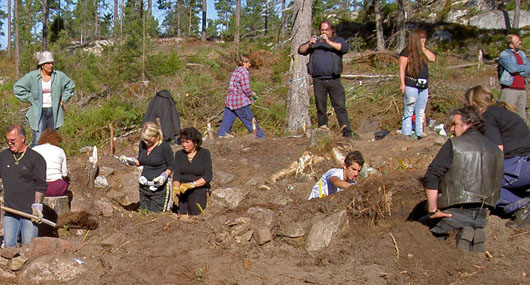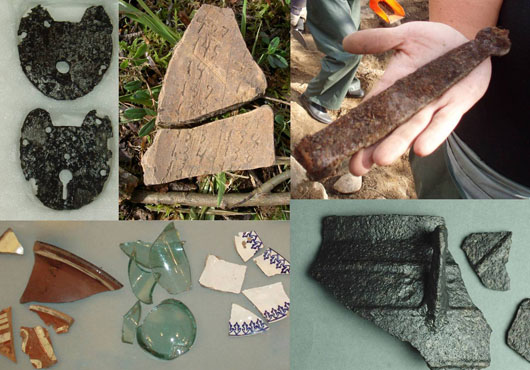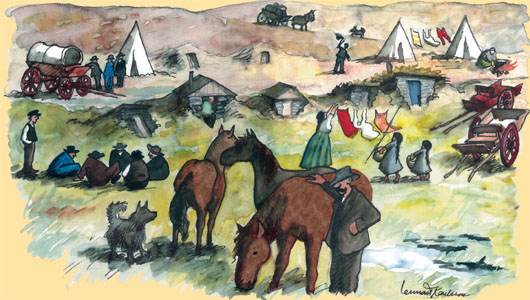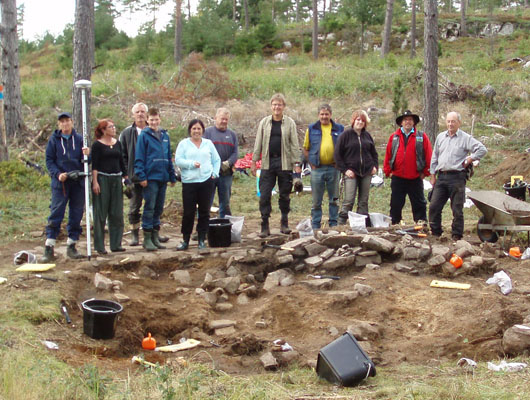The Snarsmon travellers’ settlement
Located at Ejgdefjäll in the Bullaren area in the northern part of Bohuslän, almost on the Swedish-Norwegian border, is a place called Snarsmon. At the end of the 19th century there was a traveller’s settlement here. Over five decades several families lived at the settlement for longer or shorter periods and made their living from trade and selling crafts and services in the local area in Sweden and Norway.

The foundation of one of the residential houses prior to excavation. Photo: Lars-Erik Hammar, Bohusläns museum 2002.
The history of Snarsmon
Snarsmon and its residents first appear in records around 1860. From the 1880s and 1890s there are a number of reports of around 20 travellers living on the site, and it is also likely that a large number of travellers stayed at the settlement on a temporary basis. The houses were of basic standard and spread over a stretch of about 500 metres next to a mire. One of the ways the settlers made a living was trading wares they had manufactured with the local farmers, such as baskets, steel wire pot stands, and tinwares. One Snarsmon resident was known for his great skill in making and mending weaving reeds. There were probably many other ways in which the settlers supported themselves, including cobbling and selling glassware and clocks. Travellers would adapt their means of supporting themselves to the needs of the local neighbourhood.
Snarsmon was abandoned around 1910; however, there are reports that travellers would put up for the night there into the 1920s.
The descendants of the traveller families that onced lived at Snarsmon are now scattered across Sweden. They have heard older relatives reminiscing about the site where the travellers had a village of their own. Others have also told the story about the village that was abandoned 100 years ago. Karl Sjöblom was a primary school teacher working in the Snarsmon area around 1890; in his book On the shores of Lake Bullaren from 1929 he describes a visit to the travellers’ settlement.
Returning to Snarsmon
But how much was actually true in this and other old stories about the site that was referred to as ‘a place of our own’ by the travellers themselves and ‘Tattarstan‘ [‘tattare‘ is an old derogatory swedish term for travellers] by the locals? And who were they, the people that lived at Snarsmon? One traveller family got curious about their own background and the stories they had heard about a place in Bullaren, and went there to look for it. Meanwhile, Bohusläns Museum wanted to find out more about Snarsmon as part of their ‘Ekomuseum Gränsland’ [Eco Museum Borderland] project. A meeting took place between the traveller family and members of the project team, which marked the beginning of several years of collaboration.
In 2004, travellers returned to Snarsmon together with Bohusläns Museum to explore the settlement of their ancestors and their own history. Over a period of four years, archeological explorations took place at Snarsmon for one week in September each year. Several traveller families participated in the explorations and in the search for the history of Snarsmon. Records research provided the names and dates of the people who lived there and information on how they supported themselves. The findings and experiences have been summarised in a book, Snarsmon – resandebyn där vägar möts [Snarsmon – travellers’ settlement and meeting place], and the site has become a popular visitors’ attraction.

The house icons show the locations of the different houses. There were also traces of vegetable plots in the area. Illustration: Anna-Karin Svensson.
Today, the foundations of around ten of the houses at Snarsmon have been uncovered. Some of the foundations are merely cleared bits of land which may have functioned as permanent tent pitches. Three of the foundations have been the subject of archaeological excavations. Two of them were for living in; the third the team of archaeologists believes was used as a communal kitchen. The largest of the residential houses was set into the hill so that only the roof was visible. There were traces of small vegetable plots in a few places nearby, and some holes in the ground may have been the remains of so-called clamps for storing root vegetables for winter.
Archaeological investigations
In September 2004 a team of archaeologists at Bohusläns Museum invited representatives of the Resande Romers Riksförening [Travelling Roma National Society] advocacy group, a traveller family, and interested local residents to participate in an archaeological excavation. More than 20 individuals got involved during this September week in what became the very first excavation of a travellers’ settlement in Swedish history.

The foundation of the large house after excavation. Photo: Kristina Lindholm, Bohusläns museum 2005.
The foundations of two houses were to be excavated. The first thing we encountered was a large hole in the ground filled with boulders, roots, brambles and thickets, and with a small collection of rocks next to it. Clearing the boulders and soil, gradually, bit by bit digging our way down to the foundations was hard work. Slowly but steadily the foundations of two houses emerged. The larger of the houses was set into the hill so that only the roof and the front wall were visible. The house would have had one single room, 4×5 metres in size internally. The walls were largely made from dry natural stone masonry. The smaller of the two foundations was approximately 2×3 metres in size and consisted solely of a stony foundation/wall, about 2-4 courses high. Only part of the eastern wall had been set into the hillside to achieve a level floor.

Annie Johansson and Clare Gudem investigating the foundation of the smaller of the Snarsmon houses, and Ronny Magnusson investigating the larger one. Photos: Lars-Erik Hammar och Kristina Lindholm, Bohusläns museum 2005.
There are many names for this type of dwelling that is set into the ground, for example, crofts, cottages, or dens. The terminology used depends on where the dwelling is located and what materials it was made from. There is a good deal of overlap between the different terms and it is sometimes difficult to determine what the dwelling should be called. They all have in common that they are simple structures built from locally sourced materials and under local conditions. This type of dwelling was used not only by the travellers; many of the landless and unpropertied Swedish population also lived in houses like this in the 19th century.
Amongst the rubble and soil in the Snarsmon foundations we found building debris such as nails, window fragments, ironwork fittings, and fragments of brick. Personal items found included pieces of fabric, buttons, bits of shoes, a pearl from a necklace or bracelet, a comb, parts of a hat pin, and a spectacle lens. In addition, the remains of utensils, tools and kitchenwares were found that included fragments of glassware, pottery, crockery and cast-iron kettles. These objects had been discarded, lost or left behind when the last few traveller families left the village. Those finds that can be dated can be placed in the 19th or early 20th century. Many of the objects found during the excavations form part of the Möt Resandefolket! [Meet the travellers!] exhibition at Bohusläns Museum.
After two years of excavating the residential houses we began investigating the third foundation. This consisted of a collapsed wall and a paved floor. A large collection of nails showed that the house had had timbered walls, and parts of the roof had been tiled. The objects found were mainly housewares and kitchen waste such as bones. After lengthy discussions the archaeologists and the travellers reached consensus on concluding that the dwelling had been a kitchen, possibly for communal use by several houses in the area.
The results of the excavations, together with information obtained from records research and stories told verbally during the project, allowed us to create a picture of life at the Snarsmon travellers settlement the way it was lived over 100 years ago. Seven crofts were located on the hillside sloping towards the mire. Tents would have been pitched here and there. A few horses are grazing by the edge of the mire, and several dogs can be seen around the village. The road through the village is lined with carts and carriages. Someone is preparing an evening meal, one woman and a couple of children are hanging out washing to dry. The men are sitting together on the grass chatting, perhaps about how business has been since they last met. Drawing: Lennart Karlsson.
A rewarding project
The Snarsmon project began in 2003 with an inventory of the area. Bohusläns Museum has since completed archaeological investigations of the settlement together with the Resande romers riksförening advocacy group and interested local residents, for one week each year in 2004, 2005, 2006, and 2007. Snarsmon was established as a visitors’ attraction with information boards in 2007 as part the Ekomuseum Gränsland project. During the 2007 investigation one wall was reconstructed in one of the excavated houses, and a commemorative plaque was erected.
The project continued over time with activities such as historical building surveys, archival research and ethnological tasks, and was summarised in 2008 in a book called Snarsmon – resandebyn där vägar möts [Snarsmon – travellers’ settlement and meeting place]. One important source of input for the book was a series of workshops held by the travellers who participated in the project. The contents of the book and a number of objects from the archaeological digs were included in a mobile exhibition that toured locations in Västra Götaland county and the towns of Örebro and Halden during 2010 and 2011. As of 2012, the objects and stories from the settlement and the excavations form part of a permanent exhibition at Bohusläns Museum. In addition, the project has created ripples by inspiring many other activities over the years, including a theratrical performance in Bullaren, workshops organised by ABF [the Workers’ Educational Association], new projects, etc.
These efforts were funded by the Swedish Arts Council, ABF, the Lindeberg Ancient Monuments Foundation, Tanum Town Council, the Lennart J Hägglund Foundation, Västra Götaland County Council, and Bohusläns Museum. Bohusläns Museum has collaborated with Resande Romers Riksförening [Travelling Roma National Society], Bullarens Hembygdsförening [Bullaren Local History Society], Grensehuset [the Border House] and several interested local residents.
The traveller community
Travellers have lived in Sweden for many hundreds of years, travelling from village to village offering their wares and services. In Sweden, modern-day swedish travellers form part of the Roma national minority. Bohusläns Museum has been working together with members of the traveller community since 2004 to raise awareness of the history of the traveller community as a part of our shared heritage.
Travellers map, Culture Heritage of Travellers
Read more in the summary from the book of Snarsmon
Snarsmon – travellers’ settlement and meeting place





![brosch_2_kant[2]](http://www.bohuslansmuseum.se/en/wp-content/uploads/sites/2/2015/12/brosch_2_kant2.jpg)